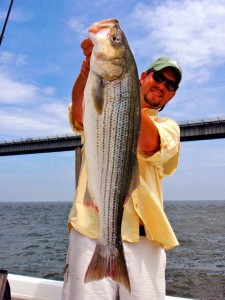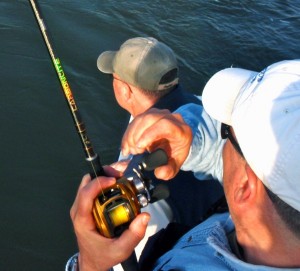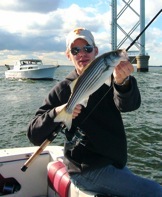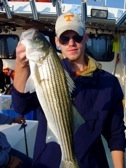jigging basics
 Have you heard? Light tackle casting is producing big fish lately on the Chesapeake Bay. Some lucky anglers are catching fish over 30-inches on almost every trip. Sometimes they get three or four. Most of the fish I’m catching are coming off cover like rocks or bridge pilings, but some have been hooked while fishing submerged structure in open water. Both soft plastics and metal jigs are producing. If you’ve been out, I hope you’re enjoying some lucky days. 30-inch plus stripers in late June is something to celebrate, especially considering how tough fishing has been previously.
Have you heard? Light tackle casting is producing big fish lately on the Chesapeake Bay. Some lucky anglers are catching fish over 30-inches on almost every trip. Sometimes they get three or four. Most of the fish I’m catching are coming off cover like rocks or bridge pilings, but some have been hooked while fishing submerged structure in open water. Both soft plastics and metal jigs are producing. If you’ve been out, I hope you’re enjoying some lucky days. 30-inch plus stripers in late June is something to celebrate, especially considering how tough fishing has been previously.
In my opinion, seasoned anglers make a lot of their own luck. Since the fish are more inclined to bite now, I thought it might be worthwhile to discuss tips for hooking and landing bigger fish – just some little things that can move fishermen up from the usual summer schoolies to true summer trophies. You probably have a few tips as well, so feel free to share them in the comments section. I’ll start with the basics: Read More!
 According to Wikipedia, sensitivity training is a method of behavioral modification that makes people more aware of their prejudices. Lately, I feel like I should be a little more sensitive. No, I don’t think I need to nicer to the trollers or more chivalrous to the ladies. I’m doing pretty good with those things. I’m thinking of the sensitivity I get when I have a jigging rod in my hands. When it comes to fishing, I want to be completely in-tune with my touchy-feely side.
According to Wikipedia, sensitivity training is a method of behavioral modification that makes people more aware of their prejudices. Lately, I feel like I should be a little more sensitive. No, I don’t think I need to nicer to the trollers or more chivalrous to the ladies. I’m doing pretty good with those things. I’m thinking of the sensitivity I get when I have a jigging rod in my hands. When it comes to fishing, I want to be completely in-tune with my touchy-feely side.
Due to the big crowds around the warm water discharges this spring, I’ve had plenty of opportunities to watch other light tackle fishermen in action. I’ve seen some very good anglers out there. On the other hand, I’ve noticed a few guys who have struggled. Other than disregarding the basic principles of stealth, the biggest mistake I see fishermen make is not feeling for their lures to touch the bottom when they’re jigging. Read More!
 Following up the previous article on basic vertical jigging techniques, I want to share what I know for kicking it into the next gear. Most of these methods are a natural progression from vertical jigging. Jigging is an extremely productive method for catching Chesapeake Bay rockfish, so it’s something you’ll want to practice and learn well.
Following up the previous article on basic vertical jigging techniques, I want to share what I know for kicking it into the next gear. Most of these methods are a natural progression from vertical jigging. Jigging is an extremely productive method for catching Chesapeake Bay rockfish, so it’s something you’ll want to practice and learn well.
Most of my techniques have been honed over time by bass & striper fishing in fresh water situations. Bay fishing is similar in many respects, but there some special considerations.
The Chesapeake Bay is very shallow compared to many striped bass environments. While suspended fish are occasionally encountered, it’s more likely that they are either feeding on the surface or holding near the bottom. Read More!
 One of the most effective techniques for catching striped bass in the Chesapeake Bay is vertical jigging with light tackle. It can be done in both deep and shallow water and will produce when all other methods fail. Rockfish in the Bay typically station themselves near underwater structure where they wait to ambush bait-fish. Since they often don’t move much it’s necessary to present a lure exactly where they are holding. Jigging is the way to catch them.
One of the most effective techniques for catching striped bass in the Chesapeake Bay is vertical jigging with light tackle. It can be done in both deep and shallow water and will produce when all other methods fail. Rockfish in the Bay typically station themselves near underwater structure where they wait to ambush bait-fish. Since they often don’t move much it’s necessary to present a lure exactly where they are holding. Jigging is the way to catch them.
Basic vertical jigging technique requires stationing the boat directly over the fish. I never drop a jig unless I’ve either located fish on the finder, or feel confident that they’ll be nearby at any moment. Make no mistake, learning to find the fish is the hardest part of light tackle fishing. Read More!


